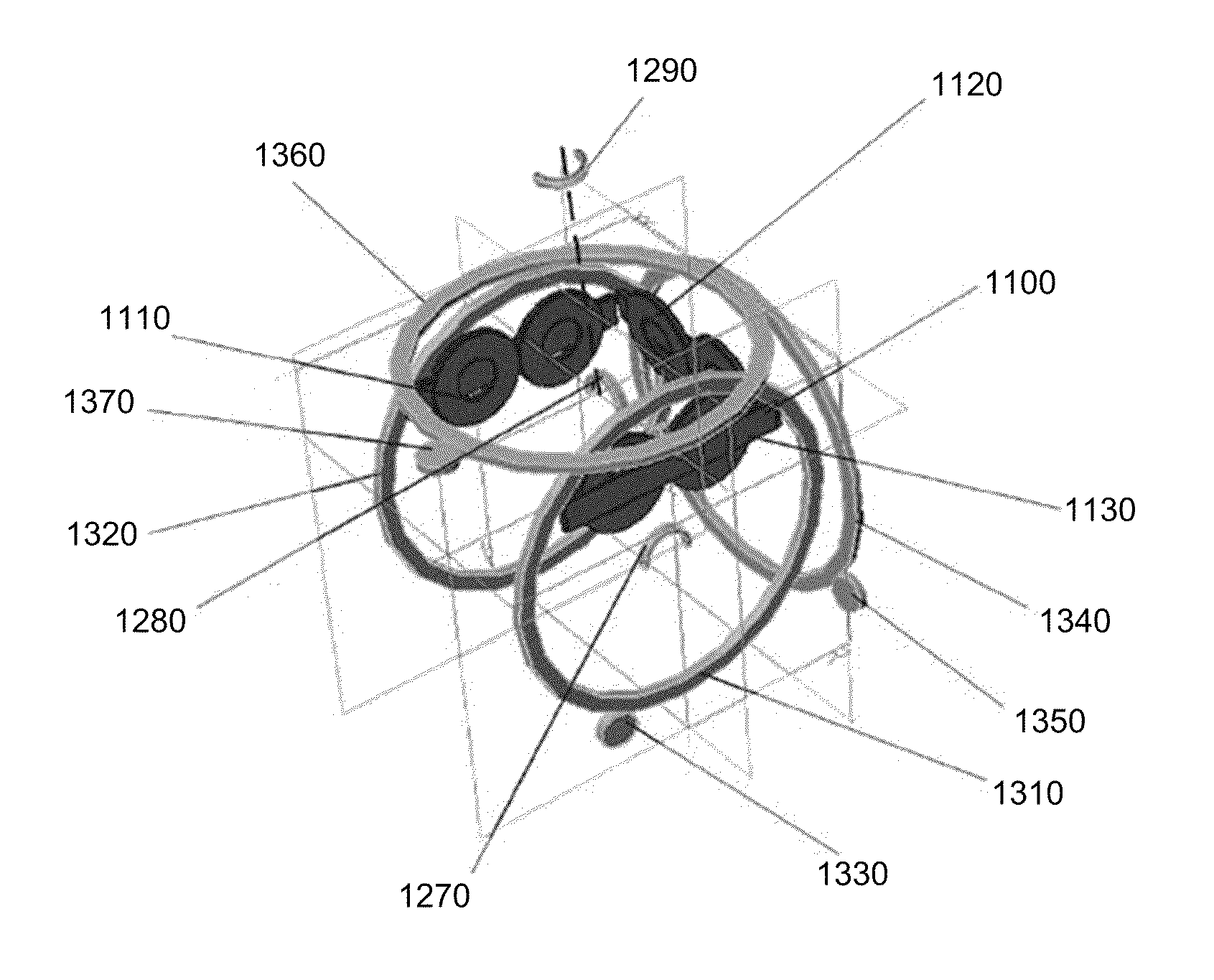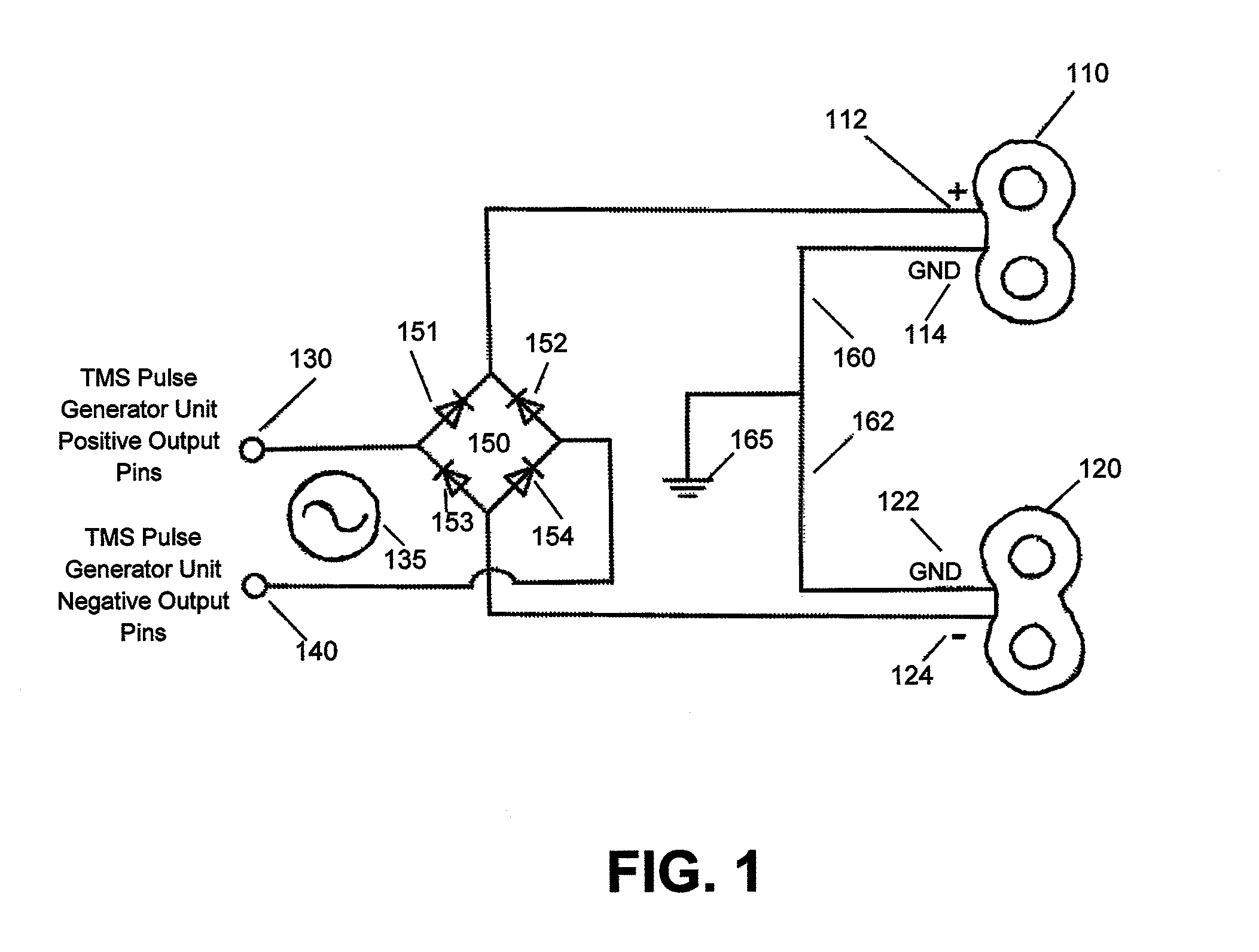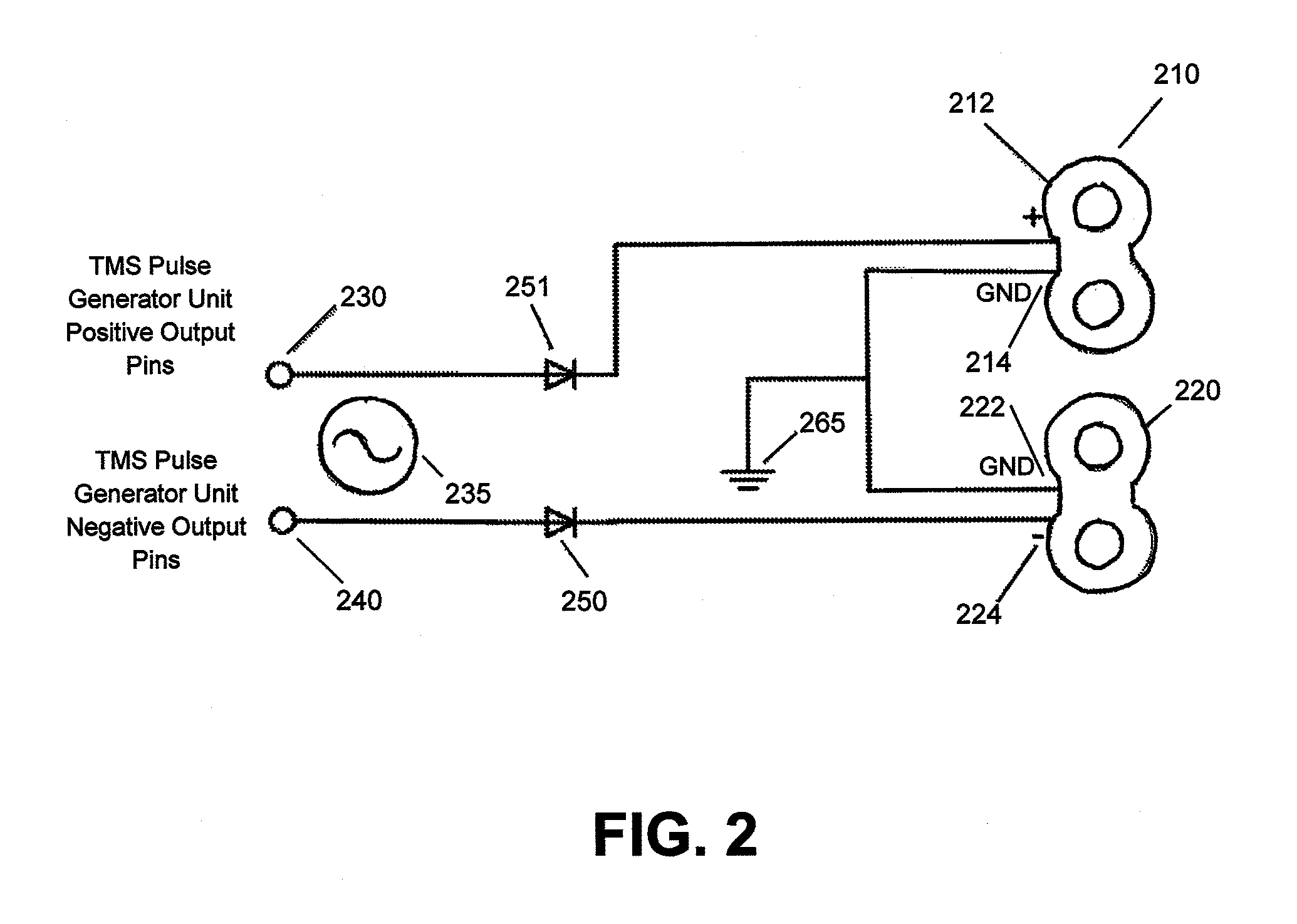[0035]As used herein, an
attractor magnet is typically a secondary
magnet positioned separately from the primary TMS
magnet(s) whose
magnetic field the
attractor magnet is configured to modify. An
attractor magnet may be isolated from the primary TMS electromagnet(s) whose field it is configured to modify. In particular the attractor magnet may be physically isolated, meaning that it may not be directly connected to a primary electromagnet. In some variations, the attractor magnet is separately maneuverable from the primary electromagnet, though it may be connected to the same gantry, framework, etc. as the primary electromagnet(s). For example, an attractor magnet may be positioned opposite from a primary TMS magnet and configured to direct, focus, or otherwise enhance the
electromagnetic field emitted by the TMS magnet, which may aid in delivering deeper, more effective Transcranial Magnetic Stimulation (TMS). Typically, TMS involves uses a large electromagnet placed near the side of the patient's head to provide
electromagnetic simulation. For the purposes of this document, the primary TMS (e.g., large) electromagnet is herein referred to as a “primary magnet,”“primary electromagnet” or a “main electromagnet”. The secondary magnets described herein, which may be located separately from the primary magnet but can be activated simultaneously or synchronously (in the case of active secondary magnets) with the primary magnet. For example, one or more attractor magnets may be located on the side of a patient's head opposite from the primary TMS magnet(s), or in the mouth or
nasal cavity, and may act as active sink for the
magnetic field from the magnet to help focus the field.
[0037]Because the magnetic fields produced by TMS magnets have complex, 3-dimensional
field strength profiles, the term “opposite” polarity may be relative. Consequently, the primary TMS magnet and an attractor magnet do not need to be positioned at 180 degrees with respect to one another. For example, a primary magnet and an attractor magnet may face 90 degrees relative to one another, and still produce the attractor effect as herein described. In some variations the attractor magnet may be moved relative to the TMS magnet (or vice versa). In general, the attractor magnet may be positioned so that the effect of the attractor magnet on the magnetic field of the TMS magnet is predictable.
[0041]Part III describes systems, devices and method for Transcranial Magnetic Stimulation (TMS) in which the TMS electromagnets are configured to move in a
pitch motion, a roll motion, a
yaw motion, or two or three of those in combination. Moving the TMS electromagnet(s) in
pitch, roll and / or
yaw during treatment may avoid over-stimulating structures and causing undesirable side effects such as seizures.
[0061]In some variations, the distance between the TMS electromagnet and the subject is adjusted by moving both the TMS electromagnets around the gantry and by moving the gantry around the patient's head. For example, when a patient's head is positioned in the center of an oval gantry, moving the TMS electromagnet closer to the
short axis of the oval will shorten the distance between the TMS electromagnet and the center of the oval; conversely, moving the TMS electromagnet closer to the
long axis increases the distance to the center of the oval. Thus, moving the TMS
electrode (which may be part of a TMS
actuator module) around the gantry changes the
radial position relative to the center of the gantry and therefore the patient, while moving the entire gantry may position the TMS
electrode relative to the region of the patient's head. The combined motions of the gantry rotation and rotation of the TMS
actuator module around the gantry, may be used to control the distance between the subject and the TMS electromagnet. In this embodiment, the TMS
actuator module typically includes one or more TMS electromagnets and at least one gantry / magnet actuator configured to move the TMS electromagnet(s) around the gantry.
[0087]Although
patient feedback / control during the TMS therapy is typically experiential, or based on the reported experience of the patient, it may also (or alternatively) be controlled by one or more involuntary, unconscious, and / or physiological patient responses. For example, successful TMS treatment may cause an involuntary or physiological response that is not recognized by the patient, such as increase or decrease in
heart rate,
blood pressure,
respiratory rate, etc. This type of ‘involuntary’
patient feedback may also be detected by the system, and may be used to modify the treatment. In some variations, the system may prevent false or erroneous reporting of conscious or volitional feedback by requiring both unconscious and conscious feedback. For example, if treating pain, the system may allow the patient to continue to adjust one or more parameter during TMS treatment (patient control feedback), as long as an ‘unconscious’
patient feedback does not indicate successful treatment (e.g., change in
heart rate,
blood pressure, etc., indicating alleviation in pain). Alternatively, the unconscious or involuntary patient feedback may be used to select the parameter controlled by the patient or the magnitude of the patient control.
[0092]Also described herein are patient-configurable Transcranial Magnetic Stimulation (TMS) methods that allows a patient to dynamically modify the TMS while a TMS procedure is being performed, the method comprising: positioning a plurality of TMS electromagnets to apply electromagnetic energy to a deep brain
target site; applying TMS to the
target site at a magnetic
field intensity and a stimulation frequency; enabling the patient to change one or more of the position of the TMS electromagnet, the intensity of the TMS stimulation, or the frequency of the TMS stimulation based the patient's experience of the applied TMS stimulation; and applying Transcranial Magnetic Stimulation to the patient at the changed position of the TMS electromagnet, intensity of the TMS stimulation, or frequency of TMS stimulation.
 Login to View More
Login to View More  Login to View More
Login to View More 


